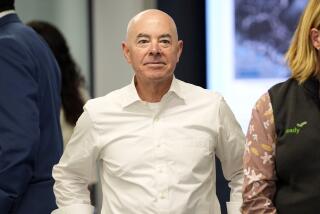CHINA IN TURMOIL : Continental and United Join in Evacuating Americans : Airlines Pressed Into Emergency Service
- Share via
NEW YORK — A State Department official phoned Lewis H. Jordan, executive vice president of Continental Airlines, late Tuesday to see if the Houston-based carrier could send an airliner to Beijing within 24 hours to evacuate Americans from the strife-torn city.
But the situation in the Chinese capital quickly grew worse, and the official called back to ask if the Continental flight could go immediately.
Continental, which does not normally fly to Beijing, agreed, considering the mission a patriotic duty. “The U.S. government sought our help to move citizens whose lives might be endangered,” said Jordan, who is also the airline’s chief operating officer. “When the State Department says that citizens have to be moved, we feel an obligation to participate.”
What followed during the next two days was a tale of some drama and many aggravations.
Trouble started quickly. When the Continental DC-10, which took off from its base in Guam, neared Shanghai, Chinese aviation authorities told the pilot that he could go no farther toward Beijing.
Circled, Flew to Okinawa
The plane circled for an hour, then flew to Okinawa. Only middle-of-the-night emergency communications among Washington, Beijing, Shanghai and Continental resolved the issue, and the plane took off again. It finally landed in the Chinese capital Thursday, having spent five hours in the air more than if it had made a direct Guam-Beijing flight.
A State Department spokesman in Washington said in an interview Thursday that the turnaround at Shanghai was apparently a misunderstanding that arose because the Continental plane arrived earlier than the Chinese had expected it.
The DC-10 was scheduled to be on the ground in Beijing for only an hour and a half. But despite reports that Americans were clamoring to get out of China, Jordan said, there were not nearly enough prospective passengers to fill the plane, which has room for 284 people. At last report, the DC-10 was still parked at the Beijing airport.
Because of the unexpected delay, the Continental crew had to check into a Beijing hotel to wait it out and get some rest.
As a precaution, Continental took one of its own mechanics along to handle any troubles that might arise. And the airline made sure that the jet had enough fuel to make it unnecessary to take on any in China.
“There was no way to know whether their fueling facilities were operational, whether they had fuel or whether their fuel was contaminated,” Jordan said. “I had to assume the worst would happen.” The plane left Okinawa with 138,300 pounds of jet fuel and still had 91,000 pounds when it arrived in Beijing.
Besides the mechanic, the plane carried other extra Continental personnel who do not usually travel. There was a load planner, who specializes in weight and balance calculations. He will measure exactly the total weight of baggage to be allowed on the plane and will decide how many people can travel and where they will sit.
A passenger service representative also was part of the crew to help the evacuees make connections later. Besides the three-member cockpit crew and 13 flight attendants, the plane also carried Continental’s chief pilot in Guam in case management decisions had to be made on the spot.
There were other complications. For example, Continental and the State Department had to see that visa requirements to enter China were waived for the DC-10’s crew, and a waiver had to be sought of the rigid 11 p.m. curfew requirements at Narita International Airport near Tokyo, which will be the plane’s first stop after leaving Beijing.
Because Continental is not a regular visitor to Beijing, the plane had no flight chart or map of the airport there. Such maps inform flight crews of such facts as the length of the runways, whether there are any unusual obstacles at the airport and the radio frequency of the air traffic control center.
United Airlines, which makes three regular flights a week to Beijing with Boeing 747s, also operated two charter flights for the State Department this week, each of which spent just one hour on the ground in Beijing.
Since the crisis began, Chicago-based United has been conducting frequent meetings of a China task force composed of key executives. In addition, it has been requiring its China office to check in by phone every four hours.
United said that its loads, too, have been light. On Wednesday, a 400-passenger plane left Beijing with 277 people aboard and picked up another 43 in Shanghai. Thursday’s charter, which did not stop in Shanghai, carried only 65 passengers.
The State Department spokesman said there was no way of knowing how many Americans need to be evacuated from China. “We are trying to contact all Americans,” he said. “There is no way to predict how many there will be.”
United feels that the small loads on the charters are the result of a habit not so unusual for Americans.
“It is a chaotic situation,” says Robert A. Doughty, a United spokesman. “There are other (non-American) airlines that people can fly out of China. They double-book and triple-book. They put their names down on the waiting list of every airline at the airport. Then they fly out on the first one they can get out on.”
Northwest Airlines, based in Eagan, Minn., and United are the only U.S. carriers that operate regular flights to China. Northwest’s flights go to Shanghai.
More to Read
Sign up for Essential California
The most important California stories and recommendations in your inbox every morning.
You may occasionally receive promotional content from the Los Angeles Times.













